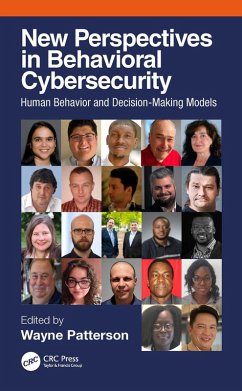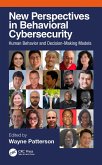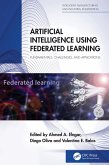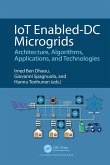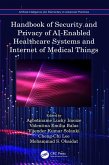New Perspectives in Behavioral Cybersecurity (eBook, ePUB)
Human Behavior and Decision-Making Models
Redaktion: Patterson, Wayne
88,95 €
88,95 €
inkl. MwSt.
Sofort per Download lieferbar

44 °P sammeln
88,95 €
Als Download kaufen

88,95 €
inkl. MwSt.
Sofort per Download lieferbar

44 °P sammeln
Jetzt verschenken
Alle Infos zum eBook verschenken
88,95 €
inkl. MwSt.
Sofort per Download lieferbar
Alle Infos zum eBook verschenken

44 °P sammeln
New Perspectives in Behavioral Cybersecurity (eBook, ePUB)
Human Behavior and Decision-Making Models
Redaktion: Patterson, Wayne
- Format: ePub
- Merkliste
- Auf die Merkliste
- Bewerten Bewerten
- Teilen
- Produkt teilen
- Produkterinnerung
- Produkterinnerung

Bitte loggen Sie sich zunächst in Ihr Kundenkonto ein oder registrieren Sie sich bei
bücher.de, um das eBook-Abo tolino select nutzen zu können.
Hier können Sie sich einloggen
Hier können Sie sich einloggen
Sie sind bereits eingeloggt. Klicken Sie auf 2. tolino select Abo, um fortzufahren.

Bitte loggen Sie sich zunächst in Ihr Kundenkonto ein oder registrieren Sie sich bei bücher.de, um das eBook-Abo tolino select nutzen zu können.
New Perspectives in Behavioral Cybersecurity offers direction for readers in areas related to human behavior and cybersecurity, by exploring some of the new ideas and approaches in this subject, specifically with new techniques in this field coming from a diverse range of scholars.
- Geräte: eReader
- mit Kopierschutz
- eBook Hilfe
Andere Kunden interessierten sich auch für
![New Perspectives in Behavioral Cybersecurity (eBook, PDF) New Perspectives in Behavioral Cybersecurity (eBook, PDF)]() New Perspectives in Behavioral Cybersecurity (eBook, PDF)88,95 €
New Perspectives in Behavioral Cybersecurity (eBook, PDF)88,95 €![Artificial Intelligence Using Federated Learning (eBook, ePUB) Artificial Intelligence Using Federated Learning (eBook, ePUB)]() Artificial Intelligence Using Federated Learning (eBook, ePUB)51,95 €
Artificial Intelligence Using Federated Learning (eBook, ePUB)51,95 €![IoT Enabled-DC Microgrids (eBook, ePUB) IoT Enabled-DC Microgrids (eBook, ePUB)]() IoT Enabled-DC Microgrids (eBook, ePUB)51,95 €
IoT Enabled-DC Microgrids (eBook, ePUB)51,95 €![Handbook of Security and Privacy of AI-Enabled Healthcare Systems and Internet of Medical Things (eBook, ePUB) Handbook of Security and Privacy of AI-Enabled Healthcare Systems and Internet of Medical Things (eBook, ePUB)]() Handbook of Security and Privacy of AI-Enabled Healthcare Systems and Internet of Medical Things (eBook, ePUB)72,95 €
Handbook of Security and Privacy of AI-Enabled Healthcare Systems and Internet of Medical Things (eBook, ePUB)72,95 €![Handbook of IoT and Blockchain (eBook, ePUB) Handbook of IoT and Blockchain (eBook, ePUB)]() Handbook of IoT and Blockchain (eBook, ePUB)47,95 €
Handbook of IoT and Blockchain (eBook, ePUB)47,95 €![Blockchain Technology for Data Privacy Management (eBook, ePUB) Blockchain Technology for Data Privacy Management (eBook, ePUB)]() Blockchain Technology for Data Privacy Management (eBook, ePUB)50,95 €
Blockchain Technology for Data Privacy Management (eBook, ePUB)50,95 €![Convergence of Blockchain Technology and E-Business (eBook, ePUB) Convergence of Blockchain Technology and E-Business (eBook, ePUB)]() Convergence of Blockchain Technology and E-Business (eBook, ePUB)55,95 €
Convergence of Blockchain Technology and E-Business (eBook, ePUB)55,95 €-
-
-
New Perspectives in Behavioral Cybersecurity offers direction for readers in areas related to human behavior and cybersecurity, by exploring some of the new ideas and approaches in this subject, specifically with new techniques in this field coming from a diverse range of scholars.
Dieser Download kann aus rechtlichen Gründen nur mit Rechnungsadresse in A, B, BG, CY, CZ, D, DK, EW, E, FIN, F, GR, HR, H, IRL, I, LT, L, LR, M, NL, PL, P, R, S, SLO, SK ausgeliefert werden.
Produktdetails
- Produktdetails
- Verlag: Taylor & Francis eBooks
- Seitenzahl: 196
- Erscheinungstermin: 27. September 2023
- Englisch
- ISBN-13: 9781000932904
- Artikelnr.: 68687433
- Verlag: Taylor & Francis eBooks
- Seitenzahl: 196
- Erscheinungstermin: 27. September 2023
- Englisch
- ISBN-13: 9781000932904
- Artikelnr.: 68687433
- Herstellerkennzeichnung Die Herstellerinformationen sind derzeit nicht verfügbar.
Dr. Wayne Patterson is a retired Professor of Computer Science at Howard University. He is also currently Co-Principal Investigator for the GEAR UP project at Howard. He has also been Director of the Cybersecurity Research Center, Associate Vice Provost for Research, and Senior Fellow for Research and International Affairs in the Graduate School at Howard. He has also been Professeur d'Informatique at the Université de Moncton, Chair of the Department of Computer Science at the University of New Orleans, and in 1988 Associate Vice Chancellor for Research there. In 1993, he was appointed Vice President for Research and Professional and Community Services, and Dean of the Graduate School at the College of Charleston, South Carolina. In 1998, he was selected by the Council of Graduate Schools, the national organization of graduate deans and graduate schools, as the Dean in Residence at the national office in Washington, DC. His other service to the graduate community in the United States has included being elected to the Presidency of the Conference of Southern Graduate Schools, and also to the Board of Directors of the Council of Graduate Schools. Dr. Patterson has published more than 50 scholarly articles primarily related to cybersecurity, one of the earliest textbooks in cybersecurity, Mathematical Cryptology (Rowman and Littlefield, 1986), and recently the first book in this aspect of cybersecurity (with co-author Cynthia K. Winston), Behavioral Cybersecurity (CRC Press, 2018) . He has been the principal investigator on over 35 external grants valued at over $6,000,000. In August 2006, he was loaned by Howard University to the US National Science Foundation to serve as the Foundation's Program Manager for International Science and Engineering in Developing Countries, and in 2017 was Visiting Scholar at Google. He received degrees from the University of Toronto (BSc and MSc in Mathematics), University of New Brunswick (MSc in Computer Science), and the University of Michigan (PhD in Mathematics). He also held Post-Doctoral appointments at Princeton University and the University of California - Berkeley.
Section I. Cybersecurity Concerns in the Work Environment. 1. Management
and Security of Financial Data Through Integrated Software Solutions. 2.
An Efficient Scheme For Detecting And Mitigating Insider Threats. 3.
(Figures query) Phishing Through URLs: An Instance Based Learning Model
Approach to Detecting Phishing. Section II. Cybersecurity Threats to the
Individual. 4. Video Games in Digital Forensics. 5. Dances with the
Illuminati: Hands-On Social Engineering in Classroom Setting. 6. Studying
Fake News Proliferation by Detecting Coordinated Inauthentic Behavior. 7.
Refining the Sweeney Approach on Data Privacy. Section III. Cybersecurity
Concerns in the Home and Work Environment. 8. Cybersecurity Hygiene:
Blending Home and Work Computing. 9. Will a Cybersecurity Mindset shift
build and sustain a Cybersecurity Pipeline?. Section IV. Ethical
Behavior. 10. Cybersecurity Behavior and Behavioral Interventions.
Section V. Differences in Languages in Cyberattacks. 11. Using Language
Differences to Detect Cyberattacks: Ukrainian and Russian. Section VI.
Applications of Behavioral Economics to Cybersecurity. 12. Using Economic
Prospect Theory To Quantify Side Channel Attacks. 13. A Game-Theoretic
Approach to Detecting Romance Scams. Section VII. New Approaches for
Future Research. 14. (Unfinished?) Human-Centered Artificial intelligence:
Threats and Opportunities for Cybersecurity.
and Security of Financial Data Through Integrated Software Solutions. 2.
An Efficient Scheme For Detecting And Mitigating Insider Threats. 3.
(Figures query) Phishing Through URLs: An Instance Based Learning Model
Approach to Detecting Phishing. Section II. Cybersecurity Threats to the
Individual. 4. Video Games in Digital Forensics. 5. Dances with the
Illuminati: Hands-On Social Engineering in Classroom Setting. 6. Studying
Fake News Proliferation by Detecting Coordinated Inauthentic Behavior. 7.
Refining the Sweeney Approach on Data Privacy. Section III. Cybersecurity
Concerns in the Home and Work Environment. 8. Cybersecurity Hygiene:
Blending Home and Work Computing. 9. Will a Cybersecurity Mindset shift
build and sustain a Cybersecurity Pipeline?. Section IV. Ethical
Behavior. 10. Cybersecurity Behavior and Behavioral Interventions.
Section V. Differences in Languages in Cyberattacks. 11. Using Language
Differences to Detect Cyberattacks: Ukrainian and Russian. Section VI.
Applications of Behavioral Economics to Cybersecurity. 12. Using Economic
Prospect Theory To Quantify Side Channel Attacks. 13. A Game-Theoretic
Approach to Detecting Romance Scams. Section VII. New Approaches for
Future Research. 14. (Unfinished?) Human-Centered Artificial intelligence:
Threats and Opportunities for Cybersecurity.
Section I. Cybersecurity Concerns in the Work Environment. 1. Management
and Security of Financial Data Through Integrated Software Solutions. 2.
An Efficient Scheme For Detecting And Mitigating Insider Threats. 3.
(Figures query) Phishing Through URLs: An Instance Based Learning Model
Approach to Detecting Phishing. Section II. Cybersecurity Threats to the
Individual. 4. Video Games in Digital Forensics. 5. Dances with the
Illuminati: Hands-On Social Engineering in Classroom Setting. 6. Studying
Fake News Proliferation by Detecting Coordinated Inauthentic Behavior. 7.
Refining the Sweeney Approach on Data Privacy. Section III. Cybersecurity
Concerns in the Home and Work Environment. 8. Cybersecurity Hygiene:
Blending Home and Work Computing. 9. Will a Cybersecurity Mindset shift
build and sustain a Cybersecurity Pipeline?. Section IV. Ethical
Behavior. 10. Cybersecurity Behavior and Behavioral Interventions.
Section V. Differences in Languages in Cyberattacks. 11. Using Language
Differences to Detect Cyberattacks: Ukrainian and Russian. Section VI.
Applications of Behavioral Economics to Cybersecurity. 12. Using Economic
Prospect Theory To Quantify Side Channel Attacks. 13. A Game-Theoretic
Approach to Detecting Romance Scams. Section VII. New Approaches for
Future Research. 14. (Unfinished?) Human-Centered Artificial intelligence:
Threats and Opportunities for Cybersecurity.
and Security of Financial Data Through Integrated Software Solutions. 2.
An Efficient Scheme For Detecting And Mitigating Insider Threats. 3.
(Figures query) Phishing Through URLs: An Instance Based Learning Model
Approach to Detecting Phishing. Section II. Cybersecurity Threats to the
Individual. 4. Video Games in Digital Forensics. 5. Dances with the
Illuminati: Hands-On Social Engineering in Classroom Setting. 6. Studying
Fake News Proliferation by Detecting Coordinated Inauthentic Behavior. 7.
Refining the Sweeney Approach on Data Privacy. Section III. Cybersecurity
Concerns in the Home and Work Environment. 8. Cybersecurity Hygiene:
Blending Home and Work Computing. 9. Will a Cybersecurity Mindset shift
build and sustain a Cybersecurity Pipeline?. Section IV. Ethical
Behavior. 10. Cybersecurity Behavior and Behavioral Interventions.
Section V. Differences in Languages in Cyberattacks. 11. Using Language
Differences to Detect Cyberattacks: Ukrainian and Russian. Section VI.
Applications of Behavioral Economics to Cybersecurity. 12. Using Economic
Prospect Theory To Quantify Side Channel Attacks. 13. A Game-Theoretic
Approach to Detecting Romance Scams. Section VII. New Approaches for
Future Research. 14. (Unfinished?) Human-Centered Artificial intelligence:
Threats and Opportunities for Cybersecurity.
